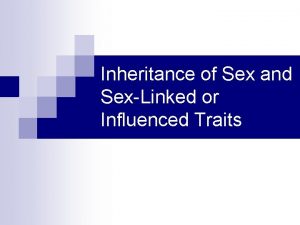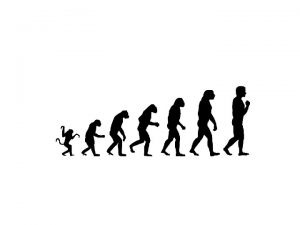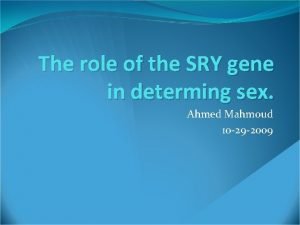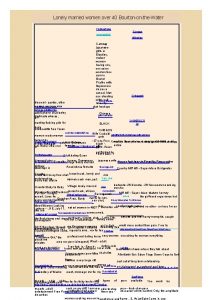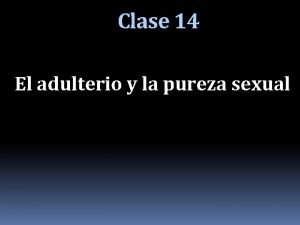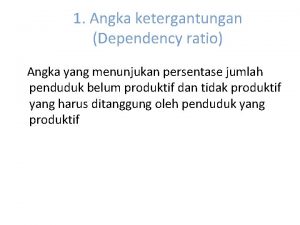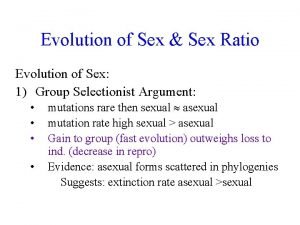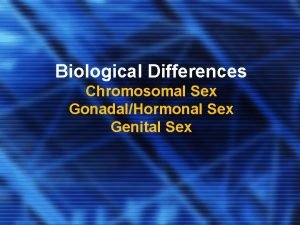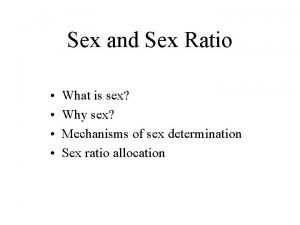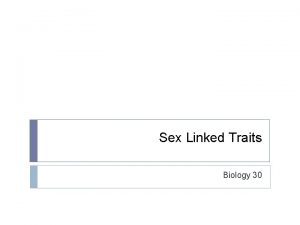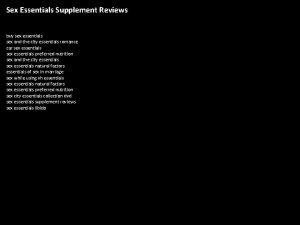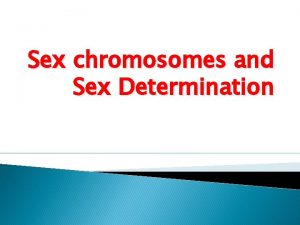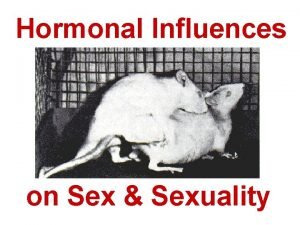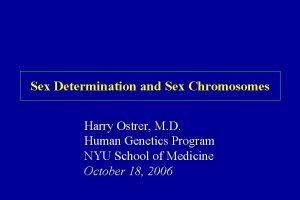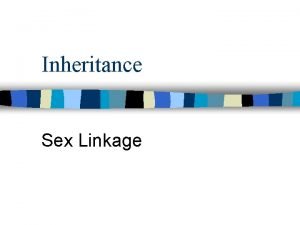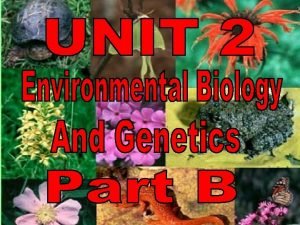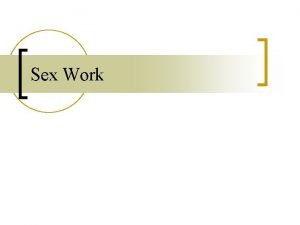Evolution of Sex Evolution of Sex I Importance



























- Slides: 27

Evolution of Sex

Evolution of Sex I. Importance Nearly universal biological phenomenon What is its advantage?

II. Back to Evolution of Sex- Frequency Asexual reproduction in an aphid

Volvox aureus, a freshwater alga female Asexual

A hydra. This individual is reproducing both sexually and asexually. The crown of tentacles at the upper left surround the hydra's mouth. Along the body below the mouth are rows of testes. Below the testes are two asexual buds. Asexual Reproduction also rarely observed in fish and reptiles


III. Evolutionary Advantage of Asexual Reproduction Maynard Smith and the Adv. Of Sexual vs Asexual Reproduction A female’s reproductive mode does not affect the number of her offspring A female’s reproductive mode does not affect the probability of offspring survival The reproductive advantage of asexual females: Two fold advantage Two fold genetic transmission advantage

IV. Linkage Disequilibrium and Sex First a quick diversion on linkage disequilibrium

Expected frequency of AB = 0. 6 x 0. 8 = 0. 48 and so forth

LD = or D = g. ABgab – g. Abga. B; e. g. = 0. 44 x 0. 04 – 0. 16 x 0. 36

LD will decay over time by a factor of (1 -r) in absence of selection


What is the origin of linkage disequilibrium? ? 1. Natural Selection (selection on 2 loci, hitchhiking) Mimulus inversions Selection on lactose tolerance and nearby neutral alleles dragged along for the ride 2. Drift (bottlenecks and appearance of a mutation) Diseases and neutral alleles: Tay-Sachs, Gaucher’s 3. Population Mixture (hybrid zones) AABB population mixes with aabb population, after only 1 generation of mating: AABB, Aa. Bb, aabb

Mimulus guttatus Figure 1. Geographic distribution of the chromosomal inversion. (A) Map of western North America with the locations of populations ofcoastal perennials (blue), inland annuals (orange), and inland perennials (purple), as well as obligate self-fertilizing species M. nasutus (yellow). (B) Marker order of the AN and PE inversion arrangements along linkage group eight. Inland annuals and M. nasutus had the AN arrangement whilecoastal and inland perennials all had the PE arrangement. doi: 10. 1371/journal. pbio. 1000500. g 001 Adaptive Inversion Contributes to Isolation PLo. S Biology | www. plosbiology. org 3 September 2010 | Volume 8 | Issue 9 | e 1000500

Figure 2. Replicated effect of the inversion locus. (A) F 2 progeny with parental ecotypic phenotypes, from a cross between the SWB (coastal perennial) and LMC (inland annual) populations. (B–E) Effect of the inversion on flowering time in four independently derived F 2 mapping populations created through crosses between independent inland annual and coastal perennial populations. (F) Effects of the inversion on flowering time in cross between inland annual and inland perennial populations. The mean flowering times (61 SE) of F 2 s that were homozygous for the AN arrangement (AA), heterozygous (AB), and homozygous for the PE arrangement (BB) at Micro 6046 are indicated. The percentage of F 2 variance/ parental divergence explained by the inversion is presented above each bar graph. Note: y-axes do not originate at zero. doi: 10. 1371/journal. pbio. 1000500. g 002

III. Evolutionary Advantage of Asexual Reproduction Maynard Smith and the Adv. Of Sexual vs Asexual Reproduction A female’s reproductive mode does not affect the number of her offspring A female’s reproductive mode does not affect the probability of offspring survival The reproductive advantage of asexual females: Two fold advantage Two fold genetic transmission advantage

Sex: Linkage Disequilibrium & Selection • Recombination (sex) brings favorable alleles together faster than mutation • Recombination (sex) allows chromatids to loose disadvantageous alleles

V. Advantages of Sex: Beneficial alleles

Recombination contributes to adaptation

Selection Snails and trematode parasites Red Queen Hypothesis (Leigh van Valen) Segregation & Recombination recreate rare, favored genotypes New Zealand Mud Snail 2 types of females: Sexual Asexual White = frequency of males


movement Nematodes introduced to: Medium with evolving pathogenic bacteria Medium with non evolving pathogenic bacteria Dead bacteria Caenorhabdtis elegans food antibiotic

VI. Advantages of Sex Drift & Disadvantageous alleles Asexuality = Muller’s Ratchet Sex = Loss of bad mutations

Recombination allows lineages to get rid of bad mutations and to put together good gene combinations boulders Caenorhabdtis elegans Advantages of Sex Evolves

Thermal stability of small subunit r. RNA: Endosymbionts < Free living


Conclusions • Both Sex and Asex are widespread • Must be advantages to both, depending on environment • Asex has 2 fold female fitness advantage, and no search cost or STD’s • Sex is advantageous because it eliminates bad mutations and brings together good mutations • Sex favors individuals in populations under selection. Sex increases response to selection
 Sex sex sex
Sex sex sex Sex sex sex
Sex sex sex Kurt bumby
Kurt bumby Sex sex sex
Sex sex sex Sex snv
Sex snv Advanced higher biology unit 2
Advanced higher biology unit 2 Sex determination and sex linkage
Sex determination and sex linkage Once a sex offender always a sex offender
Once a sex offender always a sex offender Sex determination and sex linkage
Sex determination and sex linkage Importance of sex in a relationship
Importance of sex in a relationship Sex
Sex Sex
Sex Sex
Sex Sex
Sex Ground rules for a relationship
Ground rules for a relationship Jacob syndrome
Jacob syndrome Sex
Sex Primary sex characteristics
Primary sex characteristics Brain pop sex ed
Brain pop sex ed Sry gene y chromosome
Sry gene y chromosome Sex minuters gångtest protokoll
Sex minuters gångtest protokoll Maria quintero sex
Maria quintero sex Good sex life
Good sex life Free xxx chat rooms calpella california
Free xxx chat rooms calpella california Porn hub hermanos
Porn hub hermanos Angka ketergantungan adalah
Angka ketergantungan adalah Name or code sex
Name or code sex Male sexual response
Male sexual response










